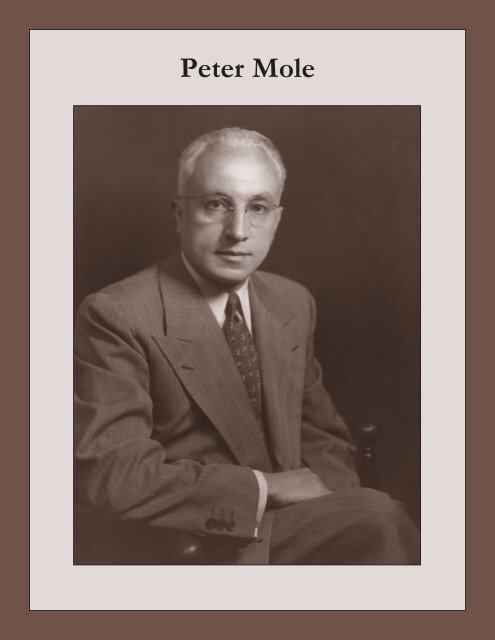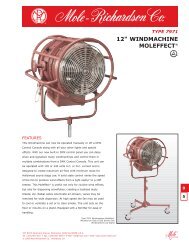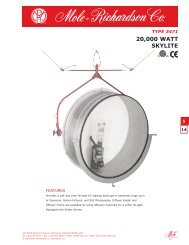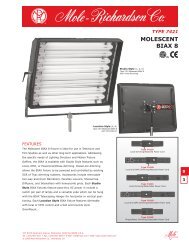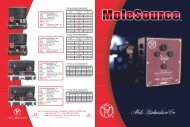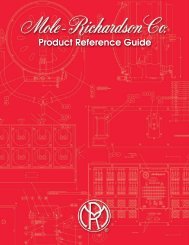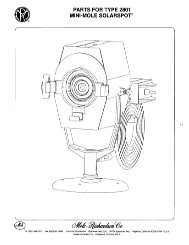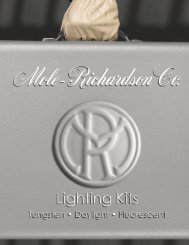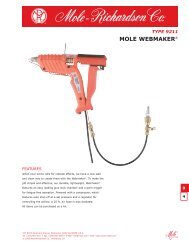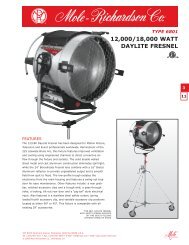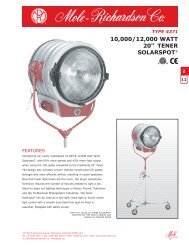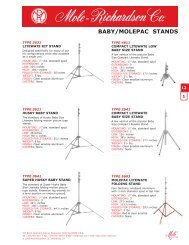Peter Mole - Mole Richardson
Peter Mole - Mole Richardson
Peter Mole - Mole Richardson
Create successful ePaper yourself
Turn your PDF publications into a flip-book with our unique Google optimized e-Paper software.
<strong>Peter</strong> <strong>Mole</strong>
<strong>Peter</strong> <strong>Mole</strong><br />
Awards & Achievements of <strong>Peter</strong> <strong>Mole</strong><br />
<strong>Peter</strong> <strong>Mole</strong> and <strong>Mole</strong>-<strong>Richardson</strong> Company were first recognized by the Academy of Motion Picture Arts and Sciences in 1928.<br />
<strong>Peter</strong> <strong>Mole</strong> supplied lighting and expertise for the Academy's Research Council on Incandescent Illumination, for which he and the<br />
company received Recognition of Valuable Service Awards, which preceded the Technical Achievement Award. <strong>Peter</strong> <strong>Mole</strong> and <strong>Mole</strong>-<br />
<strong>Richardson</strong> Company went on to receive six Academy Awards, along with other prestigious achievements which are listed below.<br />
1928 Recognition of Valuable Service<br />
Academy of Motion Picture Arts and Sciences<br />
Contributing to the Success of the Incandescent Illumination Researches<br />
(See Image A)<br />
1935 Honorable Mention for Distinctive Achievement<br />
Academy of Motion Picture Arts and Sciences<br />
Development of the "Solar-Spot" Spot Lamps<br />
(See Image B)<br />
1940 Honorable Mention for Scientific or Technical Achievement<br />
Academy of Motion Picture Arts and Sciences<br />
Important Contributions in the Cooperative Development of New Improved Process Projection Equipment<br />
(see Image C)<br />
1946 Honorable Mention for Scientific or Technical Achievement<br />
Academy of Motion Picture Arts and Sciences<br />
The Type 450 Super High Intensity Carbon Arc Lamp<br />
(see Image D)<br />
1948 Progress Medal Award<br />
Society of Motion Picture Engineers<br />
Outstanding Achievement in Motion Picture Technology<br />
(see Image E)<br />
1945 Certificate of Acknowledgement<br />
United Nations<br />
By faithful and diligent performance of duty, contributed to the creation of the Charter of the United Nations<br />
Awarded to <strong>Peter</strong> <strong>Mole</strong> for his lighting of the historic United Nations Council in San Francisco, California.<br />
(see Image F)<br />
1949 Certificate of Appreciation<br />
American Society of Cinematographers<br />
Outstanding contributions in the development of lighting equipment for cinematography.<br />
(see Image G)<br />
1966 Motion Picture Technical Milestone Award<br />
American Society of Cinematographers<br />
Contribution to the progress of the motion picture industry.<br />
Posthumous. Presented to Larry <strong>Mole</strong> Parker<br />
(see Image H)<br />
1951-1952 President<br />
Society of Motion Picture and Television Engineers<br />
Pioneered embracing Television as a viable compliment to Motion Picture instead of a rival.<br />
1931-1960 Member/Fellow/Chairman<br />
Society of Motion Picture Engineers/Society of Motion Picture and Television Engineers<br />
Possessed a unique understanding of creating specialized equipment for an emerging industry.<br />
1937-1960 Associate Member<br />
American Society of Cinematographers<br />
Published numerous papers and studies on lighting and lighting techniques.
Born in Italy, in 1891, <strong>Peter</strong> <strong>Mole</strong> arrived in the United<br />
States when he was six years old. At the age of twenty,<br />
he attended Bryan & Stratton College in Buffalo, New<br />
York, earning an Electrical Engineering Degree. After graduating,<br />
<strong>Peter</strong> <strong>Mole</strong> joined the engineering staff of the General<br />
Electric Company, where he was active in the development of<br />
the General Electric searchlight and a high-intensity rotating<br />
carbon-arc theater projection lamp.<br />
In 1923 <strong>Peter</strong> <strong>Mole</strong> left the General Electric Company<br />
and moved to California where he began working with motion<br />
picture studio lighting, first with the Metro-Goldwyn-Mayer<br />
Studios in the electrical department. After receiving his groundwork<br />
training in production, he went on to work for Creco, a<br />
motion picture studio lighting equipment manufacturer. With<br />
his technical background plus experience in the studios he was<br />
ideally suited to enter the field of the manufacture of specialized<br />
equipment for an emerging industry where requirements<br />
were changing almost monthly. With the advent of Eastman<br />
Kodak’s Panchromatic black & white film stock, he saw the<br />
possibility of creating a new incandescent fixture to replace<br />
the less efficient carbon arc light by developing the first color<br />
temperature compatible incandescent tungsten lamp.<br />
<strong>Peter</strong> <strong>Mole</strong> joined with Elmer C. <strong>Richardson</strong>, a design<br />
engineer, and Fielding C. Coates, a studio chief electrician, to<br />
form the <strong>Mole</strong>-<strong>Richardson</strong> Company in 1927. He received his<br />
first Academy of Motion Picture Arts and Sciences recogni-<br />
<strong>Peter</strong> <strong>Mole</strong><br />
A Brief Biography of <strong>Peter</strong> <strong>Mole</strong><br />
tion this same year for his contribution to the success of the<br />
incandescent illumination fixture. <strong>Peter</strong> <strong>Mole</strong> and his company<br />
went onto receive Academy Awards in 1935, 1940 and<br />
1946 for Technical Achievement. In 1948 <strong>Peter</strong> <strong>Mole</strong> received<br />
the Progress Medal Award from the Society of Motion<br />
Picture Engineers for Outstanding Achievement in Motion<br />
Picture Technology. <strong>Peter</strong> <strong>Mole</strong> was a lifelong member of the<br />
Society of Motion Picture Engineers, the American Society of<br />
Cinematographers, and in 1951 he was elected President of<br />
the newly formed Society of Motion Picture and Television<br />
Engineers, where he was instrumental in embracing television<br />
as a viable compliment to motion picture instead of a rival.<br />
<strong>Peter</strong> <strong>Mole</strong>’s technical contributions have been many,<br />
including adapting the fresnel focusing lenses to both arc and<br />
incandescent lighting equipment, developing electrical and<br />
mechanical devices such as the sound boom. He authored<br />
numerous published papers dealing with the various facets of<br />
illumination as applied to motion picture studio lighting for<br />
the SMPE, the SMPTE, the ASC, as well as serving on<br />
motion picture committees.<br />
The engineering expertise of <strong>Peter</strong> <strong>Mole</strong> afforded him to<br />
meet the demands and needs of a rapidly growing motion<br />
picture industry, wether it was developing quiet fixtures with<br />
the introduction of sound, creating a line of fixtures compatible<br />
with the newly introduced Technicolor color film or pioneering<br />
television lighting by producing a comparatively silent<br />
and cooler tungsten fixture.<br />
With the outbreak of World War II, <strong>Peter</strong> <strong>Mole</strong> directed<br />
his energy toward serving the country. His contributions<br />
included developing and manufacturing military searchlights,<br />
aircraft landing lights, and a classified tank with strobe-light,<br />
which was to be used to disable the approaching enemy. One<br />
of <strong>Peter</strong> <strong>Mole</strong>’s proudest moments came when he was commissioned<br />
by the State Department to supervise and install<br />
lighting equipment for the historic first United Nations<br />
Conference being held in San Francisco, California during the<br />
summer of 1945. His expertise was called upon to in order to<br />
record this historic event on both still and motion picture film.<br />
<strong>Peter</strong> <strong>Mole</strong> was also known for his humanitarian and<br />
philanthropic efforts throughout the Hollywood community.<br />
He was a substantial contributor to the Shiner’s Children’s<br />
Hospital, assisted in the relief efforts for the 1933 Long<br />
Beach earthquake, and along with his wife, assisted in the<br />
SMPTE Women's Guild. His generosity also extended to<br />
many area schools, including Loyola Marymount University,<br />
Notre Dame High School and Sacred Heart Academy.<br />
The success of <strong>Peter</strong> <strong>Mole</strong> in lighting was not only due<br />
to his ability to organize and operate an engineering and manufacturing<br />
organization to meet the needs of a unique industry,<br />
he also had an unusual insight into the intangibles created<br />
by the motion picture production. He knew that engineering<br />
perfection did not transcend utilization in an industry where<br />
dramatic effect is the end result; yet he was able to design and<br />
produce highly specialized lighting tools which satisfy both<br />
the artist and the engineer.
(Image B)<br />
Honorable Mention For Distinctive<br />
Achievement<br />
presented in 1935 by the<br />
Academy of Motion Picture Arts and Sciences<br />
<strong>Peter</strong> <strong>Mole</strong><br />
(Image A)<br />
Recognition of Valuable Service Award<br />
presented in 1928 by the<br />
Academy of Motion Picture Arts and Sciences
(Image D)<br />
Honorable Mention For Technical Achievement<br />
presented in 1946 by the<br />
Academy of Motion Picture Arts and Sciences<br />
<strong>Peter</strong> <strong>Mole</strong><br />
(Image C)<br />
Honorable Mention For Technical Achievement<br />
presented in 1940 by the<br />
Academy of Motion Picture Arts and Sciences
(Image F)<br />
Certificate of Acknowledgement<br />
along with a Letter of Gratitude<br />
presented to <strong>Peter</strong> <strong>Mole</strong> in 1946<br />
by the United Nations.<br />
Shown right is a photograph of <strong>Peter</strong> <strong>Mole</strong><br />
at the United Nations Conference.<br />
<strong>Peter</strong> <strong>Mole</strong><br />
(Image E)<br />
Progress Medal Award<br />
presented in 1948 by the<br />
Society of Motion Picture Engineers.<br />
Shown with an <strong>Peter</strong> <strong>Mole</strong> authored<br />
SMPE publication.
(Image G)<br />
Certificate of Appreciation<br />
presented in 1949 by the<br />
The American Society of Cinematographers<br />
(Image H)<br />
The American Society of Cinematographers<br />
Motion Picture Technical Milestone Award<br />
Honoring <strong>Peter</strong> <strong>Mole</strong><br />
Presented by King Vidor and<br />
accepted by Larry <strong>Mole</strong> Parker<br />
<strong>Peter</strong> <strong>Mole</strong>
<strong>Peter</strong> <strong>Mole</strong><br />
<strong>Peter</strong> <strong>Mole</strong> at the 1931<br />
Society of Motion Picture Engineers meeting being<br />
held at the American Legion Auditorium.<br />
Left: A 1931 snap shot of George “Spanky” McFarland sleeping inside<br />
a <strong>Mole</strong>-<strong>Richardson</strong> fixture.<br />
Below: <strong>Peter</strong> <strong>Mole</strong> pictured in 1929 with Joe Cobb, Allen Hoskins,<br />
Bobby Hutchins and the rest of the cast of “Our Gang”.
Right:<br />
<strong>Peter</strong> <strong>Mole</strong> viewing a <strong>Mole</strong>-<strong>Richardson</strong><br />
fixtures with Director Frank Tokunaga<br />
and Actress Komako Sunada.<br />
Below:<br />
<strong>Peter</strong> <strong>Mole</strong> attending the<br />
1928 Academy Awards at<br />
the Hollywood-Roosevelt<br />
Hotel.<br />
<strong>Peter</strong> <strong>Mole</strong>
Right:<br />
<strong>Peter</strong> <strong>Mole</strong> displaying<br />
some of his<br />
numerous awards<br />
<strong>Peter</strong> <strong>Mole</strong><br />
Left:<br />
<strong>Peter</strong> <strong>Mole</strong>, SMPTE President<br />
with Lucille Ball and Desi Arnaz<br />
during the Society of Motion<br />
Picture and Television Engineer<br />
70th semi-annual convention at the<br />
Hollywood Roosevelt Hotel.


